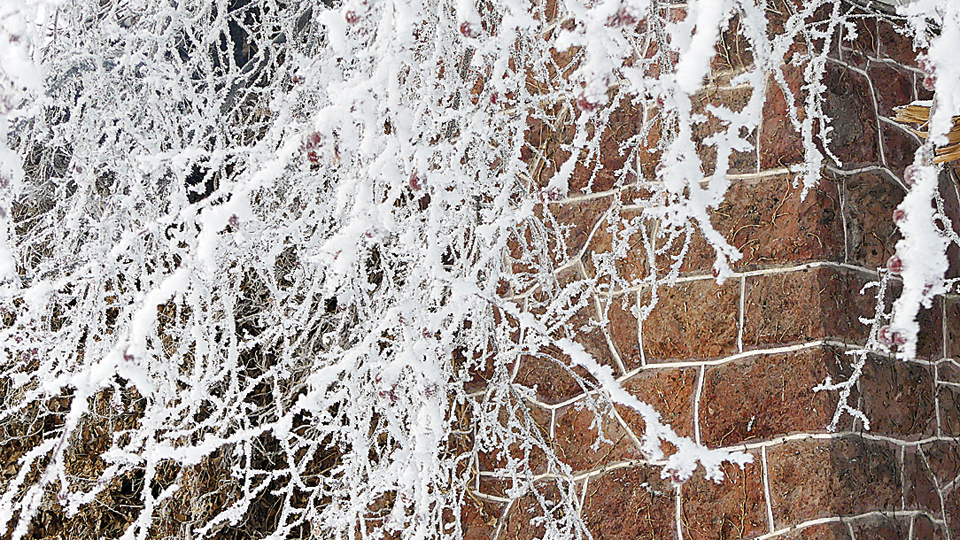
 Snow and ice flock branches outside a Vale office building. Colder than normal weather has been covering Malheur County. (Malheur Enterprise/John Braese)
Snow and ice flock branches outside a Vale office building. Colder than normal weather has been covering Malheur County. (Malheur Enterprise/John Braese)By Pat Caldwell
The Enterprise
VALE – A peculiar blend of weather this season has shut down roads, delivered more snow, and wrapped the area in colder than usual temperatures.
The culprit for the icy mixture isn’t the typical winter weather pattern, said Dave Decker, program leader with the National Weather Service in Boise.
“It’s mainly because there is a really strong high up over Alaska. That is allowing a lot of the colder, arctic weather to spill down south,” he said.
Decker confirmed what is obvious to those who live in the upper Treasure Valley: Temperatures in December were colder than usual by an average of 10 degrees.
The new year is starting out with more snow likely and at least two days with very cold temperatures.
According to the National Weather Service, Thursday night’s low will be 1 degree with a low of 4 Friday night. There will also be a 20 percent chance of snow Saturday and a 50 percent chance of snow Sunday.
The upper Treasure Valley’s geography plays a role in sustaining inversions.
“With your lower elevation, everything kind of pools,” he said.
One of the coldest temperatures recorded in Vale occurred on Dec. 26, 1924 when the temperature fell to 35 below.
Severe weather plays havoc on area roadways.
Joe Arnold, station manager for the Oregon Department of Transportation, said so far the number and frequency of winter squalls has been challenging.
“You don’t get much time between storms. And the lower temperatures have been pretty severe this winter,” said Arnold, who manages state highway crews in Vale and Ontario.
Arnold said his crews have been fully engaged in road clearing operations.
“The have been very busy. People have been working 12-hour shifts the entire month,” he said.
Arnold said so far his crews remain ahead of the snow and keep area roadways open. When main arteries are closed – such as Interstate 84, it’s typically because of severe weather farther north.
“It is due to road conditions places like Meacham,” he said.
Regionally, the Transportation Department faces acute weather conditions in places like Ladd Canyon and Cabbage Hill on a weekly basis.
“This is a pretty severe winter compared to other winters,” said, Tom Strandberg, ODOT spokesman in La Grande.
ODOT has closed the freeway between Pendleton and Ontario more often this year than in recent winters, Strandberg said. When conditions become too severe in a place like Meacham – between La Grande and Pendleton – the interstate will be closed all the way to Ontario.
The severe weather creates a cascading effect in other ways, he said. Snow falls, then high winds roll through an area like the Baker Valley and big drifts spill across the interstate.
Then humans enter the picture.
“People don’t realize how nasty it can get and they hit the blowing snow and then cause crashes,” he said.
Blowing snow creates whiteout conditions and at that point plow crews face few choices, he said.
“There no amount of plowing or sanding you can do when it is blowing snow with whiteout conditions,” he said.
Closed highways also carry a financial impact. According to the American Highway Users Alliance, millions are lost each day a major transportation artery is shut.
Strandberg said while the financial impact is relevant, public welfare comes first for ODOT.
“We don’t want to close the road arbitrarily. Our crews are out there and working in pretty severe conditions and our primary concern is safety,” he said.
Also, as temperatures drop, homeowners may want to keep a few key tips in mind. Remember to plug up air leaks as air entering cracks in a foundation will cause problems. Cupboards on outside walls should be open to allow in heat. To keep water pipes from freezing, run the water in faucets about a pencil width in diameter.
Sheree Hughes of Vale Veterinary Clinic offered tips to keep animals warm and safe.
“If you have outside animals, take them into a garage or a barn,” Hughes said.
Hughes also suggested dog owners check water sources and invest in heated water bowls. If you must keep your dogs outside, Hughes said owners should check on them twice a day and at night.
Also, Hughes said outside cats and dogs can find warmth with heated animal beds. Hughes also said animal owners can buy thermal dog coats to help them stay warm.
Outside animals also burn more calories in a cold snap, Hughes said.
“They need more food because they use more of their energy,” Hughes said.
Hughes said that owners of inside pets should keep pathways through snow and ice available for when they go outside.
However, Hughes said the key element to keep animals safe is basic: Make sure they have shelter.




